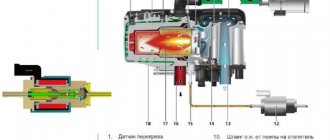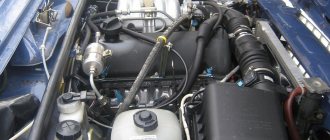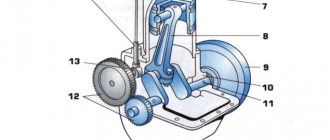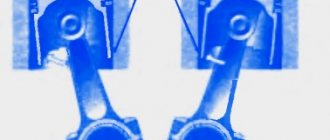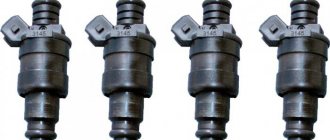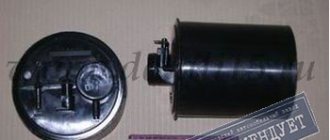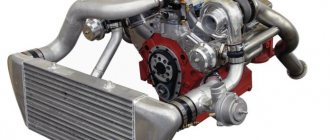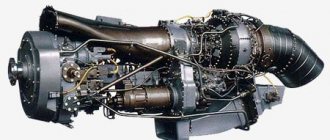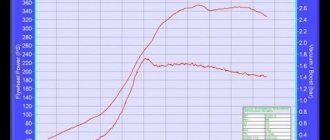Design and principle of operation of a diesel unit
The design of this equipment can be represented by two types of compressor units:
- Porshnev;
- Screw.
Devices of the latter type are most widespread. They belong to mobile positive displacement diesel compressors and operate as follows. Air is sucked into the unit through a special filter, which is equipped with replaceable elements. In this block, the air is purified and directed to the multifunctional regulator. And only after this the air masses enter the screw block, where they are mixed with oil and compressed.
The mixture resulting from these actions, passing through the radiator, enters the output of the diesel compressor. In this case, the oil is separated in the separator and supplied to the screw block. The thermostat valve controls its movement, sending it in a small or large circle, depending on the temperature. However, before the oil enters the screw block, it is cleared of solid particles by passing through filters.
The diesel compressor design also includes:
- Engine (electric or internal combustion);
- Fan;
- Minimum pressure valve
The screw block of the device consists of worm rotors:
- Presenter;
- Slave.
They are meshed and are responsible for the air compression process, which is carried out as follows. Despite the fact that the teeth of the blocks are in mesh, a kind of container is formed between their open cavities and the body of the screw block, into which air is pumped when the rotors rotate. During operation of the device, the cavities close and the volume between them decreases, which leads to an increase in pressure. When it reaches the required value, compressed air begins to flow into the discharge pipe.
To complete the full compression cycle, one revolution of the drive rotor is required. If you compare the operation of a screw device with a piston device, the difference in the compression process is clearly visible. In a piston diesel compressor, this occurs due to the reciprocating movement of the piston in the cylinder.
Increasing engine power: danger, cooling
The main condition for proper operation of the supercharger is proper cooling. Most often you can find oil and complex cooling (antifreeze + oil).
The first method appeared along with the concept of turbocharging. However, the physicochemical properties of the material very quickly absorbed the temperature, causing boiling. As a result, coking occurs, and the conductive channels quickly become clogged.
Despite the fact that such a turbine is simple in design and relatively cheap, the demands on oil quality increase significantly. If replacement is untimely or the quality of the lubricant is poor, all malfunctions of the oil system will immediately appear.
With complex cooling, a separate oil circuit and antifreeze system are installed. This significantly improves the quality of turbine operation, but complicates its design.
The oil, as in the first case, serves to cool and lubricate the supercharger elements, and antifreeze prevents overheating of the oil and is supplied from the general engine cooling circuit.
An additional element of the cooling system is the intercooler. After some time of continuous operation, the turbine begins to generate hot air. As you know, the higher the air temperature, the less oxygen it contains. In order not to reduce turbocharging performance due to this, an auxiliary cooler - an intercooler - began to be integrated into the design.
Before choosing and installing a turbocharger, it is better to familiarize yourself with the principle of its operation:
Tuning a car with a centrifugal supercharger is a common way to increase engine power. Today, automobile manufacturers have overcome a lot of problems on the way to safely increasing engine efficiency - the turbine operates constantly and most efficiently at a certain speed. Specialists in every possible way complement the turbine design to achieve the most productive results.
The principle of operation of turbocharging in a car
Any car owner at least once in his life has had the dream of increasing the power and performance characteristics of his iron horse, and such thoughts arise not only among owners of budget cars, but also among owners of powerful sports supercars. And this dream can be realized. Technical progress has brought into our lives the opportunity to tune and modernize any equipment. Increasing engine power is possible by installing additional equipment in the form of a turbine, or as it is also called, a turbocharging system. It can be installed on any engine, regardless of type and brand. If turbocharging is already installed, then tuning is based on improving its performance characteristics.
Turbine in section
Turbocharging - what does it give?
Engine tuning to obtain an increase in power can be done in various ways. In the case of a turbine, the cylinders are intensively filled with a fuel-air mixture. Air suction is performed automatically. If you do not install turbocharging, then you can increase power only by increasing the volume of the cylinders. In this case, increased fuel consumption will be observed, and the engine itself in the car will have to be more massive.
To avoid an increase in engine weight and fuel consumption, it is necessary to increase the intensity of the supply of the fuel-air mixture. For these purposes, a turbine is installed, which acts as a supercharger.
Depending on what type of turbocharger is installed and what engine, this tuning allows you to achieve an increase in power of 1.5-2 times. At the same time, despite popular belief, there will be no harm to the engine, especially if the cooling and oil supply systems are properly configured. To understand this, it is worth considering how turbocharging works.
Types of turbocharging systems
Turbocharging installed on modern engines can be divided into 3 types:
- Resonant. Particularly widespread on engines with distributed injection. The work is based on the kinetic energy of the air volume, and the pressure of the air-fuel mixture increases at the moment the intake valve opens;
- Gas turbine. It is more popular and is driven by exhaust gases;
- Volumetric blower. The drive of such turbines is carried out mainly by a belt drive, and it works on the principle of a conventional mechanical compressor.
Since the most common type is gas turbine systems, we will consider the design and operating principle of turbocharging of this particular type. So, a turbine is a mechanism consisting of a housing in which a shaft and impeller rotate. A pneumatic actuator is mounted on the structure, the role of which is to activate the bypass valve, which is necessary to regulate the rotation of the turbine. That is, it looks like this: in the process of pumping air by the compressor, the pressure increases, at this moment the pneumatic drive opens the valve and releases part of the gases into the exhaust system, thereby reducing the speed of rotation of the turbine.
its working disadvantages and the principle of a turbocharger
Video: Operating principle of a turbocharger (turbine)
The principle of operation of turbocharging is quite simple: exhaust gases enter the chamber of the turbine wheel and causes it to rotate. As it rotates, it moves the turbocharger through the rotor. For its part, it sucks in the air space, compresses it and feeds it into the intercooler for cooling.
After passing through the intercooler, the pressurized air space is supplied to the intake manifold. The operation of the boost is controlled and regulated by a pressure regulator, which meters the amount of exhaust gases entering the turbine wheel chamber. That is why it is possible to transform the performance of turbocharging depending on the rotation of the crankshaft.
But this design has one significant drawback - when the throttle valve is opened sharply, the turbocharger does not have time to provide the required amount of air to the cylinders. For this
it takes a certain amount of time.
This results in the formation of a negative result, which has come to be called “turbo lag”. In other words, the driver quickly presses the gas pedal, expecting to quickly accelerate, but due to lack of air, acceleration does not occur immediately. The car will begin to power up only after the boost has provided the required amount of air. another
appears – “turbo catch”.
It occurs at the end of the “turbo lag” and is accompanied by increased pressure in the turbocharger due to the intensive operation of the compressor.
There are a couple of ways to solve the problem of “turbo lag” and “turbo boost”. The first of them is the use of combined supercharging (consisting of a turbocharger and a mechanical supercharger). At the initial stage, when you sharply press the gas pedal, the pressure in the exhaust manifold is supplied by a mechanical supercharger, the operation of which does not depend on the exhaust gases; at the end, the turbocharger comes into operation, and the mechanical one is turned off.
Video: malfunctions and turbine design
The second method of overcoming “turbo lag” is the use of double turbocharging, the so-called “twin-turbo”. Twin turbocharging is mostly used on V-twin engines.
And the third method is the use of variable geometry turbocharging. In such a turbine, the air flow is optimized by transforming the area of the channel through which the air space is supplied.
Turbocharging
Turbocharging is a way of increasing the power of a car engine by increasing the air supply to the cylinders without changing its (engine) volume.
The main element of the system is a turbocharger, consisting of a turbine and a compressor (supercharger). Moreover, the turbine begins to work as soon as the engine starts, and the compressor only from a certain number of revolutions. The role of enriching the fuel-air mixture with oxygen is assigned to the compressor (supercharger). This process occurs by using the energy of exhaust gases. The wheels (“impellers”) of the turbine and compressor are mounted on the same shaft. Exhaust gases enter the turbine housing through the exhaust manifold, spinning its wheel, which in turn spins the compressor wheel, as a result of which air is sucked from the atmosphere into the compressor, and then it is compressed and forced into the inlet.
Classic type of turbine, using exhaust gases
This type is now used very widely, I also wrote about it - read this material . Needless to say, this is the most productive device. The shaft revolutions inside can reach 200,000 per minute, just imagine the air flow it can pump!
The operating principle is simple
Exhaust gases come from the engine, under pressure, in the muffler. Through a special outlet they fall on the turbine impeller and spin it up; on the other side there is another impeller that sits on the same shaft as the first one, it also spins up and begins to pump air into the engine cylinders. The revolutions, as I already wrote above, are simply amazing.
However, there are problems here too - due to the fact that it operates at high temperatures, and the exhaust can reach up to 950 degrees Celsius, the resource of such a unit is limited. Already after 150 - 200 kilometers, you need to either change or repair - which “leaks out” to a very large amount, now, in my opinion, from 70,000 rubles.
Also, the shaft bearings are lubricated with engine oil; at high speeds, it can pass into the turbine chambers, which entails consumption. Therefore, oil consumption for such turbines is normal.
Pros:
— The most productive type at the moment
— No connection to the engine
— Now the most common type, spare parts can be found everywhere
Minuses:
— Small resource
— Works with high temperatures
— “Eats” oil
— Demanding on fuel quality
— There is such an effect as turbo lag.
— ON older models, you need to cool down after work, which entails installing a turbo timer
As you can see, there is high performance here, but there are a lot of problems. Which are now being decided by large concerns, primarily German ones.
Pros and cons of equipment
Among the advantages it is worth highlighting:
- Low vibration level;
- High reliability and durability;
- Low operating costs for maintenance and operation.
In addition, the devices have compact dimensions, are quite lightweight and can operate up to 40 thousand hours without repair, subject to proper use. They are equipped with new generation diesel engines, which feature minimal fuel consumption, which keeps costs to a minimum.
Let's watch the video, aspects of equipment selection:
The design features of the devices ensure their continuous operation over a long period of time. It does not require constant human supervision. Diesel compressors of this class produce air in a specific pressure range, which allows the consumer to save on the purchase of additional equipment.
Criterias of choice
The purchase of a mobile diesel compressor should be carried out taking into account the main criteria for its use
First of all, pay attention to the type of drive. If you intend to use the equipment at a remote construction site or when repairing roads near which there is no power grid, then it is worth buying a diesel unit
They are able to work autonomously and do not depend on the availability of electricity.
If you plan to work with several devices at once, then you need to choose a model of appropriate power.
The cost of equipment is also one of the main aspects of choice. Based on this, we can recommend Atmos products. Its products are of high quality at reasonable prices.
Popular compressor models
The domestic market offers customers various types of such units. They differ in design and manufacturer's brand.
Atlas Copco Products
Among the most popular products are the company's products:
- Atlas Copco;
- Airman;
- Porta.
Diesel units of the Belgian manufacturer are distinguished by reliability, low fuel consumption, and convenient operation.
They are represented by a wide range and are classified by:
- Constructions;
- Pressure;
- Productivity.
The company produces both mobile and stationary models. Moreover, the latter can be equipped with supports. Mobile ones, on the contrary, are characterized by maximum mobility and can be towed at speeds of up to 90 km/h.
Mobile diesel models from Atlas Copco
The pressure of various Atlas Copco models ranges from 7 to 35 bar, and the productivity reaches 65 m³/min. Such devices are equipped with Deutz or Caterpiller engines that meet the most stringent requirements of European environmental standards.
Indispensable equipment in the construction industry
Devices of this class have been used for a very long time. Most often they can be seen during road works. The jackhammers used in these operations require a constant supply of compressed air. Mobile diesel compressors cope with this task perfectly.
This type of equipment is also indispensable for trenchless laying of pipes, their blowing and pressure testing, ensuring the operation of pneumatic punches, sandblasting and other similar devices.
Watch the video, the scope of application of the unit:
It is possible to use diesel compressors as a backup source of air supply for enterprises. And since they are autonomous and do not depend on electricity, they can be delivered to any construction site and put into working order in the shortest possible time.
What is the difference between a turbocharger and a turbocharger?
In general, engines with installed turbocharging or a turbocharger are colloquially called “turbo engines”, “turbocharged engines” and similar names, where the “turbo” part appears mainly. A turbocharged engine produces much more overall power at the same operating conditions than a similar engine without a turbo or compressor.
The typical additional (to standard atmospheric pressure) pressure pulse supplied to the cylinders by a turbocharger or supercharger is approximately 0.4 to 0.55 bar (or almost the same number of atmospheres). At normal atmospheric pressure of 1 atmosphere, you can see that the engine thus receives approximately 50 percent more air. So one would expect to get a 50% increase in engine power, right? But the air supplied under pressure, unfortunately, is not so effective, although, however, getting a 30 percent increase in power is normal for modern cars. Let's now move on to the main question: what is the difference between a turbocharger and a turbocharger?
The key difference between a turbocharger and a turbocharger is the power supply system of each. Agree, something must compress and then supply compressed air to the engine, which requires additional energy! In both cases, the power comes from a rotating movement with a fan, which forces air into the engine. In the case of a turbocharger, the torque is transmitted through a belt drive, which is connected directly to the engine. It receives rotation in the same way as, for example, a generator. A turbocharger, on the other hand, is powered by the flow of exhaust gases: the exhaust passes through the turbine, spinning it, putting pressure on the blades, and the turbine, in turn, spins the compressor. This is the difference between a turbocharger and a turbocharger!
There are disadvantages, advantages and trade-offs to both systems. In theory, a turbo is more efficient because it is driven by using the wasted energy of the exhaust gas stream as its power source. On the other hand, a turbocharger causes some amount of back pressure in the exhaust system and tends to provide much less boost while the engine is running at low speeds. On the third hand, turbochargers are much easier to install, but, as a rule, cars with turbochargers are more expensive.
Purpose of an automobile turbocharger
Working principle of a turbocharger
Now the answer to this problem is the use of a turbocharger, also known as turbocharging, turbocharger. The essence of the operation of this device is to ensure increased air pressure supplied to the cylinders of the power plant. Thanks to the use of a turbocharger, designers were able to increase power output without the need for structural transformation of the engine, increasing the speed of the chambers and the combustion volume of the crankshaft.
Along with the
The fuel consumption of a turbocharged engine will be lower due to its more complete combustion in the cylinders.
Turbochargers are now installed on both gasoline and diesel engines. But at the same time, installing a supercharger is more effective on diesel installations. This is due to the peculiarities of how the engine works - in a diesel engine, the compression ratio in the cylinders is almost twice as high as in gasoline engines, and the crankshaft rotation speed is lower.
Turbocharger design
Operating principle of the turbocharging system
The turbocharger itself includes an air intake with air filter, throttle body, turbocharger, intercooler (charge air cooler), controls and intake manifold. All these
The elements are connected to each other by pressure hoses and pipes.
The main element of this entire system is the turbocharger, because it supplies pressurized air to the system. It consists of two wheels mounted on one rotor. The compressor housing consists of two chambers, each of which has its own wheel.
Cross-section of a car turbocharger
The first wheel of the compressor is a turbine wheel. It takes on the energy of the exhaust gases and transfers it through the rotor to the second wheel. In other words, the turbine wheel is the drive wheel.
Because it works with heated gases, this wheel is made, and besides this, its chamber is made of heat-resistant materials.
The second wheel is a compressor wheel. It acquires rotation from the drive wheel and is driven. This wheel sucks in air space through the air intake, compresses it, increasing the pressure, and passes it on.
Free rotation of the rotor is ensured by the presence of plain bearings. These bearings are floating, in other words, there is a gap between them, the housing and the rotor. These bearings are lubricated by the total lubrication of the motor.
To prevent oil from leaking out and from entering the atmosphere or treated gases, sealing rings are used in the design.
1 – turbine impeller; 2 – compressor impeller; 3 – shaft; 4 – bearing unit; 5 – oil supply fitting; 6 – regulator. boost pressure.
Most turbochargers use an air cooling system, but some gasoline engines also have a liquid compressor cooling system, which is part of the engine cooling system.
An intercooler is included in the turbocharging assembly to provide cooling of the compressed air. During operation of the turbocharger, the air space heats up, which leads to a decrease in its density. When cooled, the density increases again and the pressure increases. The intercooler is
simple radiator.
It can cool the air space using both
air and liquid cooling. At the end of the intercooler, the air space is supplied to the intake manifold, and after that to the cylinders.
The turbocharger includes control elements that ensure proper functioning. The main control element is the pressure regulator. This regulator is a bypass valve. This valve regulates the amount of exhaust gas supplied to the turbine wheel.
This valve operates based on the readings of the boost pressure sensor, which is part of the engine control system. This valve supplies only the required amount of exhaust gases, bypassing the rest of the turbocharger.
In addition, the turbocharging control system can include another safety valve, which is installed behind the compressor. It provides protection against possible pressure surges in the aggregate when the throttle is closed abruptly. This valve can either bleed off excess pressure or transfer excess air space to the inlet of the turbocharger.
Turbine selection
The correct choice of turbine will determine how much engine power will increase and fuel consumption will potentially decrease. Of course, if your car comes standard with a turbine, it can be replaced with a similar unit. You can search for it by VIN code, the code of the unit itself, or the vehicle parameters. But what if the vehicle did not initially include a turbine? Let's look at what you should pay attention to when choosing a unit:
- Size and volume . For engines with a volume of 2 liters or more, large turbines are suitable. For everyone else, small ball bearing turbochargers. If the engine volume exceeds 3 liters, it is worth installing a pair of turbines;
- Pressure . Everything is simple here: the pressure in the manifold should not exceed the boost pressure by 2.5 times or more;
- Valves . Most turbines have internal valves, which is sufficient;
- Heat resistance . It is different for turbines for diesel or gasoline engines. It is enough to clarify this point with the seller.
Please note that if you plan to install the most efficient turbine specifically for your engine, then calculations and comparison of several turbine parameters are mandatory. Among them: compressor wheel efficiency, air flow, air flow, compression ratio, A/R (sectional area to radius), relative density (important for selecting an intercooler). But if you are simply counting on increasing the efficiency of the engine, then you can study the parameters of the turbines in advance, and then contact the seller for help.
Malfunctions and their diagnosis
With its rather simple design, the turbocharger can develop many malfunctions. The main ones are:
- Oil leakage through ingress and sealing rings into the atmosphere supplied to the cylinders;
- Air leakage at the connection points of the pipes;
- Clogging of the oil drainage channel from the compressor;
- Clogged oil supply channel;
- Malfunctions of the control set;
- Cracks and deformation of the compressor housing;
- Clogged air filter;
Many emerging problems with the operation of turbocharging can be signaled by exhaust gases. light blue smoke from the pipe will indicate oil entering the atmosphere, dark blue smoke will indicate an air leak, and white smoke will indicate that the oil outlet channel is clogged.
In addition, the turbocharging and the engine itself can tell about malfunctions with turbocharging. Loss of acceleration dynamics will indicate problems with turbine control, a whistle when the engine is running will indicate an air leak between the engine and the compressor, and deformation of the housing will be accompanied by a grinding noise.
Despite the malfunctions and their shortcomings, more and more cars are equipped with turbochargers, because this device is really necessary.
Types of turbines: bushing and ball bearing turbines
Bushing-type turbines have been very common for quite a long time. They had a number of design flaws that did not allow them to fully enjoy the benefits of a turbo engine. The emergence of more efficient new generation ball bearing turbines is gradually replacing bushing solutions. As an example, we can mention Garrett ball bearing turbines, which are the crown of engineering and are used on many racing engines.
Today, ball bearing turbines are the optimal solution, as they require significantly less oil compared to their bushing counterparts. Please note that installing an oil restrictor at the inlet to the turbocharger is very desirable, especially if the oil pressure in the system is above 4 atm. The oil must be drained by means of a special supply to the pan, taking into account that the drain must be above the oil level.
Always remember that oil drains from the turbine independently and under the influence of gravity. Knowing this dictates the need to orient the central turbine cartridge so that the oil drain is directed downward.
The indicator that determines the reaction of the turbine to pressing the gas pedal demonstrates a strong dependence on the design of the central turbine cartridge itself. Ball bearing solutions from Garrett are capable of reaching boost 15% faster than their bushing counterparts. Ball-bearing turbines reduce the effect of turbo lag and make using a turbo engine as similar as possible to driving a naturally aspirated engine that has a large displacement.
Ball bearing turbines have another positive point. Such turbines require a noticeably lower flow of oil, which passes through the cartridge and lubricates the bearings. The solution significantly reduces the likelihood of oil leakage through the seals. Ball bearing turbines are not overly demanding on oil quality, and are also less susceptible to coking after a planned or sudden engine shutdown.
